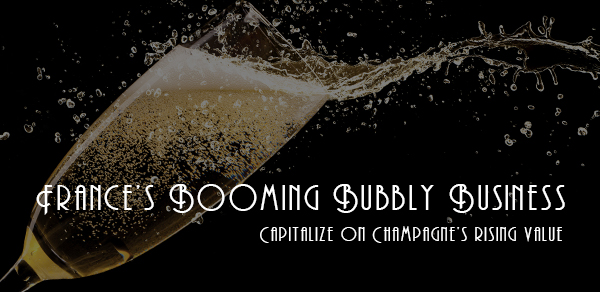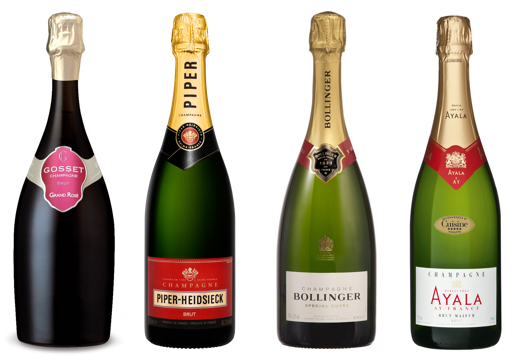France’s Booming Bubbly Business
Nov. 2, 2016

The French bubbly business is burgeoning! Champagne has seen a significant rise in value the past few years thanks to price increases and a heavy focus on premiumization. Champagne’s per-case value rose 10% from 2010-2014, and more than doubled that incremental growth in 2015 alone, adding nearly $55 in value to the average case of the sparkling French wine.*.jpg?h=163&w=1020&la=en&hash=4D4AC54EF527046005D2EE55A4276354AAF3C0F5)
We sat down with two of our fine wine specialists, Jennifer Tietz and Matt Schneider, to talk Champagne – from the region, to the product, and everything in between.
Breakthru: What makes the champagne region and its products unique?
JT: What’s great or unique about Champagne is that it’s a region that’s very based on blending techniques. Part of the reason for this is because it’s a very northern region and the climate is very variable. The weather vintage to vintage is very unpredictable, so in order to maintain consistency, they’ve come up with techniques of blending vineyards, blending grapes of course, and blending vintages, which is something you don’t see all over the place. You can contrast this to a place like Burgundy, which is very based on small, single-vineyard sites. They talk a lot about vintage character from year to year and how important that is. Champagne kind of takes the other direction. Champagne is a beverage that’s very much based on the process they use, which is the Champagne method. And that’s at the base of what makes it so delicious.
MS: What makes the region is terroir, the soil and the climate. It’s very unique in that it is probably one of the coolest grape growing regions there is. That has a lot to do with the fact that they want to retain acidity because acidity is a huge component of Champagne. You can’t have extraordinarily ripe fruit. You’re actually looking for something that is a little less ripe and higher in acidity to make your finished wine.
Breakthru: Why is it that Champagne is tied to celebrations and special occasions?
JT: I think there are a number of reasons there. I think historically you see a lot of the royalty using Champagne and bubbles in a celebratory fashion. You have a lot of historical quotations from royal or famous women about how much they love Champagne. I think it’s also a fun beverage. It’s easy to enjoy; you don’t have to think too much about it; you can have it at any time; you don’t need food to enjoy it. You can have it before a meal, during a meal, at a party – there’s really no bad time for Champagne.
MS: I think it’s tied to being a celebratory beverage due to its sparkling aspect. So, it’s the idea of Champagne and it’s also the price. I think when you’re going out celebrating, you’re a little bit more apt to spending extra money on a bottle of wine than say if you were just out to have dinner.
Breakthru: Why is Champagne pricier than many other wines?
MS: It’s pretty unique; Champagne is a relatively small region. Pretty much every grape-growing region in the world tries to mimic Champagne; they’re the home of sparkling wine. It’s where the concept of secondary fermentation really was founded, so it’s kind of like the birthplace of all sparkling wine. Part of it is also due to the process – it takes a lot of time to make Champagne. With Champagne, once you’ve got your grapes, you start your fermentation; you’ve got anywhere from three years to five years before you have a product you can sell, so there’s a lot of money held up in wine barrels so to speak.
Breakthru: Any recent trends in the Champagne world?
MS: In the last four or five years there’s been a lot of trends – one is going to really, really smalltime producers and smalltime grower Champagnes. But also at the same time, Champagnes are being turned back on their head and a lot of the bigger houses – the Taittingers and the Heidsiecks of the world – are out there putting themselves forward again with a really, really high-quality product. It’s hard to look at and walk away from.
Breakthru: Is it possible to get a good bottle of Champagne without breaking the bank?
JT: You can look at regions like the Aube and Côte de Sézanne, which are lesser known, but they make very good Pinot Noir-based Champagnes in the Aube that I love to drink. Even those are starting to get more recognition, and are starting to go up in price, but you could pick up a $30 bottle of Aube Champagne that would be absolutely delicious.
Breakthru: What does Champagne’s future look like?
MS: I think Champagne will always be Champagne, but the one thing that we really are seeing is climate change. Climate change is really affecting places like Champagne. As the world warms in a region where you need a cooler climate to retain the acidity in grapes, you tend to have to keep moving north. That’s why a lot of the big Champagne houses are now investing in Britain. In Great Britain they’re actually making some really great sparkling wine that has never really been exported, at least to the U.S. for the most part. I think that’s going to be the new hot sparkling region in the next 10 years. It still has time. Houses like Taittinger are investing there, so you know that something’s going on.
Breakthru: Any interesting facts about Champagne we may not know?
JT: When you hear of Champagne Charlie it’s referring to Charles Heidsieck. He was the guy that looked at the American market in the early 20th century and saw this big opportunity for Champagne – whereas it was already doing very well in Europe and certainly in France. He brought over propaganda more or less, in the form of posters, and he really made Champagne big in the U.S., which is why people called him Champagne Charlie..jpg?la=en&hash=7C9AE435131C2C8FD59AD3B85CFB4670D644C067)
When we think of Champagne, most envision a tall, slender, elegant glass, filled with the perfect pour of pale, effervescent bubbly. We know these glasses as Champagne flutes, and they have long been the iconic glassware for Champagne. The reason being that the tall nose of the glassware extends or emphasizes the effect of the bubbles. The downside; however, is that flutes quickly kill Champagne’s aroma. Tietz says she prefers to enjoy Champagne in glassware with a big, bulbous stem.
“I think Champagne is delicious out of a burgundy [glass]; then you can swirl it around to get the aromas, and really get a sense of what’s going on in there.”
Tietz says even an all-purpose white wine glass works nicely for enjoying Champagne, and fine wine counterpart Schneider agrees. “The more and more people are leaning towards using regular glasses, the more and more I like it. I think you get the true nature of Champagne – both the aromatics and the texture.”
To help push the trend forward, Schneider recommends providing your guests with a flute and a regular wine glass to encourage people to taste Champagne from both to really discover the differences.
.jpg?la=en&hash=73DCF49D9E2A29B547FB4CC09CD32F8DB30D9AC8)
Get enlightened on France’s sparkling wine by checking out these stats and fast facts:
- Sparkling super premium price tier represents 34% of Sparkling business and is up +16.5%
- Per-case value is up 20% to over $334 last year
- The U.S. overtook the U.K. as Champagne’s top export market by value in 2015
- Champagne shipments to U.S. leapt 28% to $573 million in 2015
- Champagne bubbles are vehicles for the flavor and smell of Champagne
- Champagne bubbles fly to the surface at a velocity of nearly 10 feet per second
- The discovery of Champagne was a mistake due to changing climates in France
- By the time Champagne goes flat, nearly 2 million bubbles have escaped from the glass
As the holidays are approaching, consumers will be reaching for the bubbly. Make sure you’re well-stocked on French Champagne to satisfy your customers.
Talk to your sales consultant today about Breakthru’s Champagne portfolio, including the below selections: (from left to right) Gosset Grand Rosé Brut, Piper-Heidsieck Brut, Bollinger Special Cuvée, Ayala Brut

Sources:
http://www.shankennewsdaily.com/index.php/2016/06/29/15298/bubbly-booming-u-s-becomes-champagnes-top-export-market/*
http://www.smithsonianmag.com/arts-culture/the-science-of-champagne-the-bubbling-wine-created-by-accident-20961157/?no-ist